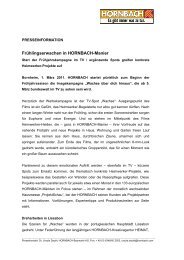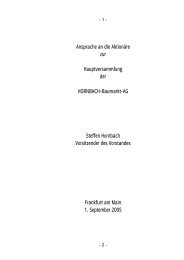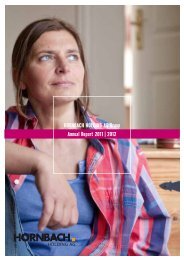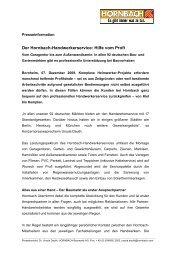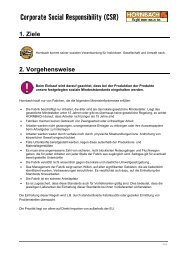Hornbach-Baumarkt-AG Group
PDF, 3,6 MB - Hornbach Holding AG
PDF, 3,6 MB - Hornbach Holding AG
- No tags were found...
You also want an ePaper? Increase the reach of your titles
YUMPU automatically turns print PDFs into web optimized ePapers that Google loves.
NOTES TO THE CONSOLIDATED FINANCIAL STATEMENTS Other Disclosures 145<br />
Interest rate risk<br />
At the end of the year, the <strong>Group</strong> was principally financed by a euro bond with a nominal total of € 250,000k<br />
and by unsecured promissory note bonds with total equivalent nominal values of around € 100,000k<br />
(2011/2012: € 120,000k). Furthermore, the <strong>Group</strong> also has long-term fixed-interest euro loans amounting to<br />
€ 21,647k (2011/2012: € 42,428k), and long-term CZK loans amounting to € 6,801k (2011/2012: € 8,294k).<br />
The principal long-term financial liabilities with floating interest rates have been converted into fixedinterest<br />
financial liabilities using derivative financial instruments.<br />
The sensitivity analysis provided below is based on the following assumptions:<br />
In the case of fixed-interest primary financial instruments, changes in market interest rates only impact on<br />
profit and loss or equity when such instruments are measured at fair value. Primary financial instruments<br />
measured at amortized cost are therefore not subject to any interest rate risk as defined in IFRS 7. The same<br />
applies to financial liabilities which originally had floating interest rates, but which have been converted into<br />
fixed-interest financial liabilities by means of cash flow hedges.<br />
Changes in the market interest rates of interest derivatives designated to hedge primary financial instruments<br />
with floating interest rates within the framework of a cash flow hedge impact on the hedging reserve<br />
within equity and have therefore been accounted for in the equity-related sensitivity analysis.<br />
Changes in the market interest rates of primary financial instruments with floating interest rates impact on<br />
the income statement and have therefore been accounted for in the sensitivity analysis.<br />
In the sensitivity analysis for interest rate risks, it has been assumed that the volumes as of the balance<br />
sheet date are representative of the financial year as a whole. A parallel shift in the interest rate structure<br />
curve has been assumed.<br />
If the market interest rate had been 100 basis points higher at the balance sheet date, and all other variables<br />
had remained unchanged, then consolidated earnings before taxes would have been € 3,007k higher<br />
(2011/2012: € 3,868k) and equity before deferred taxes would have been € 2,678k higher (2011/2012:<br />
€ 4,783k). Conversely, if the market interest rate had been 100 basis points lower at the balance sheet date,<br />
and all other variables had remained unchanged, then consolidated earnings before taxes would have been<br />
€ 3,007k lower (2011/2012: € 3,868k) and equity before deferred taxes would have been € 2,812k lower<br />
(2011/2012: € 5,044k).<br />
Credit risk<br />
Credit risk involves the risk that a contractual party is unable to comply in part or in full with the obligations<br />
entered into upon the conclusion of a financial instrument. The credit risk of the <strong>Group</strong> is strictly limited to<br />
the extent that financial assets and derivative financial instruments are concluded as far as possible with<br />
contractual parties of good credit standing. Moreover, transactions with individual contractual partners are<br />
subject to a maximum limit. The risk of receivables default in the operating business is already considerably<br />
reduced on account of the retail format (cash & carry). The maximum credit risk is basically equivalent to the<br />
carrying amounts of the financial assets.



